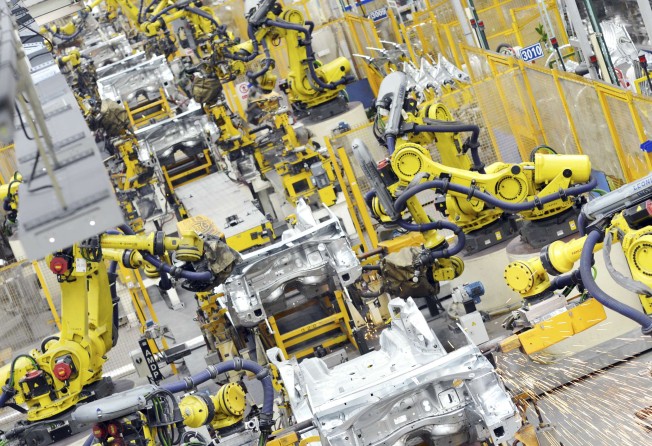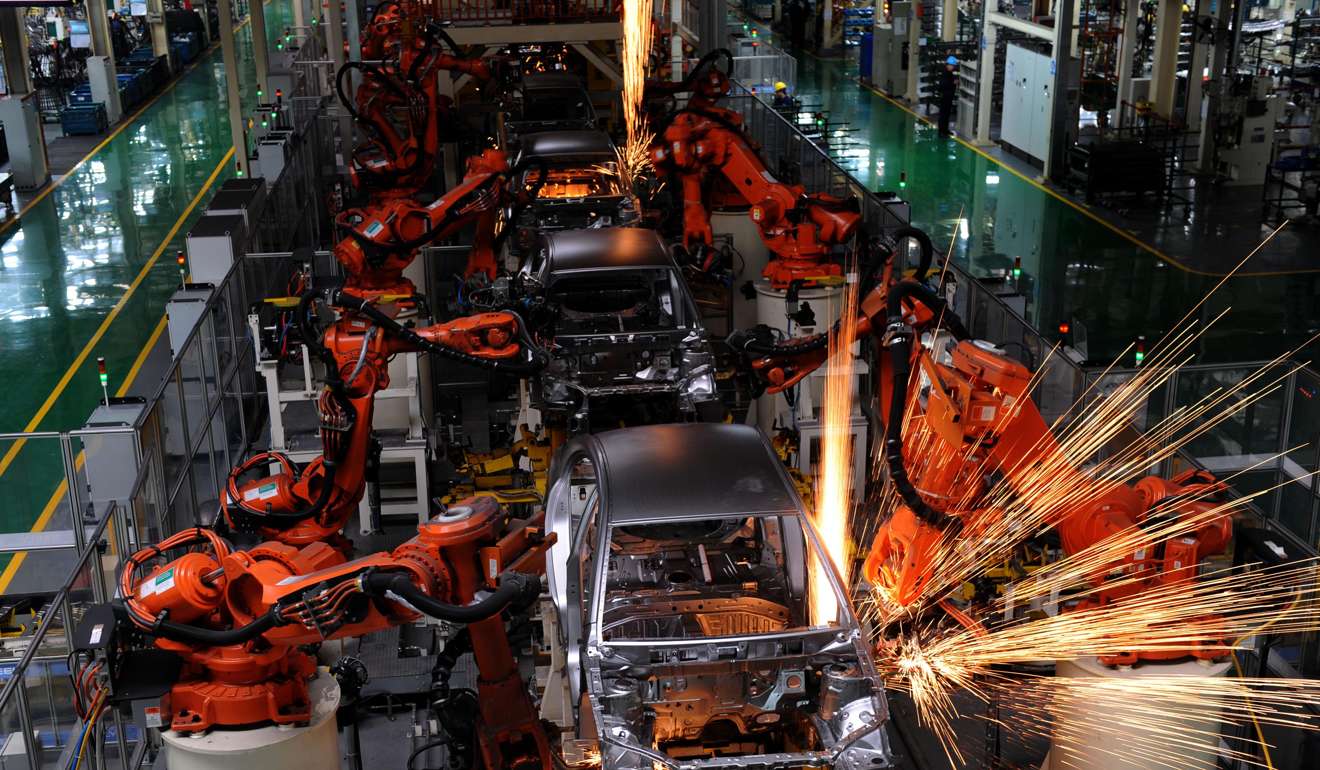Massive investment planned in ‘Made-in-China’ industrial robots
100,000 industrial robots set to be built annually by 2020, with sales of service robots also expected to exceed 30 bn yuan by then, according to official forecasts

China has seen rapid growth in its research and development spending due to strong demand of reducing labour costsand increasing productivity, which should help further the country’s automation sector, according to analysts.
A working paper from the International Monetary Fund (IMF) showed just how fast China’s innovation input, measured by R&D (research and development) expenditure, increased by an average 22 per cent annually from 1998 to 2013, reaching US$190 billion in 2013.
During the same period, the country’s innovation output, or the number of domestic applications for invention patents, rose from 36,000 in 1998 to 825,000 in 2013.
The IMF working paper is typical of wider evidence which concludes there is now sufficient evidence to support the case that the increase in Chinese companies’ patenting activity is closely related to rising innovation and higher real productivity.
“While our evidence suggests Chinese A-shares have been turning more cash-flow positive, the above conclusions [by the IMF working paper] are that companies will still spend on automation rather than outright capacity increases as local operating costs rise, ” said Sean Darby, Kenneth Chan, and Irene Zhou, equity analysts for Jefferies, in a recent research report.
In 2015, innovators in China filed a record 1.01 million patents both domestically and abroad, making up more than 30 per cent of global patent applications, according to figures from the World Intellectual Property Organisation (Wipo). Many of these patents were in telecoms, computing, semiconductors and medical technology.
Nevertheless, there are some critics who argued that rising patent filings in China were simply a function of government related goals.
Jefferies analysts say there is a plethora of academic evidence that shows the positive relationship between a company’s patent applications and its financial ratios, such as size, productivity and export shipments.
They do cite the IMF working paper as confirming that the rising levels of innovation has led to “productivity improvement”, which is contributing to China’s spectacular growth.

Driving Chinese companies’ surging innovation input, or R&D spending, was their strong intention to reduce operating costs through automation, said Jefferies analysts.
“The demand [of industrial robotics] became stronger as manual wages grew, with robots increasing their productivity and quality controls,” they said.
From 2010 to 2014, industrial robot demand increased 4 per cent annually.
Since 2013, the country’s vast manufacturing robotics industry has become increased automated on the factory floor.
In April 2016, the Chinese authorities unveiled the Robotics Industry Development Plan from 2016 to 2020 and pledged to support the expansion of the nation’s industrial robotics industry.
The plan projected that China will be able to produce 100,000 Made-in-China industrial robots annually by 2020 and produce 500,000 industrial robots with six axis (those with six have greater flexibility than robots with fewer) or more annually. Sales of service robots will also exceed 30 billion yuan by 2020, according to the plan’s forecast.

“China’s industrial robotics market became the world’s largest in 2013 and has continued to grow at a fast pace,” Jefferies analysts said.
“Similar to our US theme, investors should overweight on the automation sector,” they said.
In a separate report issued earlier this year, Darby, Chan, and Zhou suggested investors to “sell humans, and buy robots” in the US market, because companies will need to invest more in automation as wage pressures build alongside a strong greenback.
Chinese companies face a similar dilemma as wages have increased sharply and the labour force has shrunk due to the ageing problem.
Foxconn, the Taiwanese electronics maker and a leading manufacturer of apple’s iphones, has replaced 60,000 factory workers with robots in its Chinese factories.
Jefferies analysts suggested investors watch several beneficiaries of China’s growth in artificial intelligence, including Hong Kong-listed Sunny Optical, which produces dual cameras and advanced driving assistance system, and Shenzhen-listed Hikvision, which supplies smart cameras and video surveillance solutions.
Jefferies offered a “Buy” rating on both stocks, which means they expect them to provide a total return of 15 per cent or more within a 12-month period.
The analysts say Sunny Optical’s financial ratios continue to improve, with net cash on the balance sheet.
“Using our popular Du Pont analysis, ROE (return on equity) and ROIC (return on invested capital) have climbed over the past five years helped by improving asset turnover,” they said.
In the meantime, Hikvision has also been cash flow positive since the fiscal year of 2006, with net cash on its balance sheet at the end of fiscal 2015.
Hikvision’s ROE has increased from 29.5 per cent in fiscal 2010 to 34.43 per cent in fiscal 2015.
Other Chinese companies involved in automation business may also be worth some attention, including Shanghai-listed Shanghai Baosight Software, WuXi Xinje Electric, and Shenzhen-listed Zhejiang Jingsheng Mechanical & Electronical, they added.